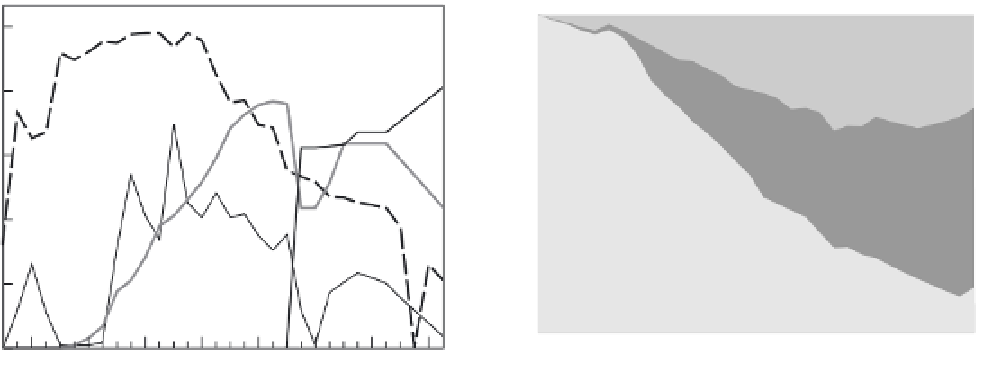Environmental Engineering Reference
In-Depth Information
100
100
Herb
P
80
80
60
60
Shrub
N
40
40
Moss
Tree
H
20
G
C
20
T
0
0
1970
1974
1978
1982
1986
1990
1994
1998
1970
1974
1978
1982
1986
1990
1994
1998
Ye a r
Year
Fig. 10.7
As for Fig. 10.6: relative importance
of cover degree of growth forms in 1968-99
(free development). T, therophytes; G, geophytes;
H, hemicryptophytes; C, chamaephytes; N,
nanophanerophytes (shrubs); P, phanerophytes (trees).
Values for 1994 and 1996-8 are interpolated. Based
on Schmidt (1993), with new values for 1993-9 added
(Schmidt, unpublished observations).
Fig. 10.6
Succession experiment in the New Botanical
Garden of Göttingen, Germany. Cover degree of
moss, herb, shrub and tree layers 1968-99 (free
development). Woody species at first are less than
5 m high (shrub layer); in 1989 some of the growing
trees reached a height of more than 5 m: shrub layer
decreases and tree layer starts suddenly. The tree-layer
curve is shaded. Values for 1994 and 1996-8 are
interpolated. Based on Schmidt (1993), with new
values for 1993-9 added (Schmidt, unpublished
observations).
As a consequence, there are two main options for
forest restoration.
suitable for tree growth immediately. Two long-term
permanent plot studies have been established in
Germany for analysing the vegetation processes after
abandonment of former agricultural areas, includ-
ing analysis of the influence of different treatments:
(i) an abandonment experiment in Baden-Württemberg
(Schiefer 1981, Schreiber 1997) and (ii) a succession
experiment in the New Botanical Garden of Göttingen
(Schmidt 1993; Figs 10.6 and 10.7). Although the aims
of these two studies, as well as the analysed vegeta-
tion types, the geographical situation and to some
degree the methods of recording, are different, after
two decades of unmanaged stand development it is
obvious that trees may become established quite
early and build up forest stands within a few decades,
whereas the successional pathway may be quite differ-
ent. The species composition and the period involved
in the changes depend on the local species pool as
well as the vegetation structure at the beginning of
the developmental process.
1
If there is time enough available and no fixed species
composition planned for the future forest stand, then
doing nothing and waiting is an option. Depending
on (i) the presence/absence of mature trees in the
close vicinity and (ii) the presence/absence of small
individuals of shrubs and trees in the recent veg-
etation stand, a patch mosaic will establish includ-
ing a large variety of species and structural types,
thus leading to a high degree of biodiversity. The
final stage of management-free development will be
a relatively closed forest canopy anyway, which then
will result in a decline in the species diversity and
in the structural diversity of the forest understorey.
2
Usually, however, the highly valued functions of
forests, as mentioned in section 10.2.2, require
work to start as soon as possible, to adapt both
species composition and forest structure to the
functions being focused on. Therefore, usually a
guided development
of such forest stands is pre-
ferred. Following the concept of close-to-nature






